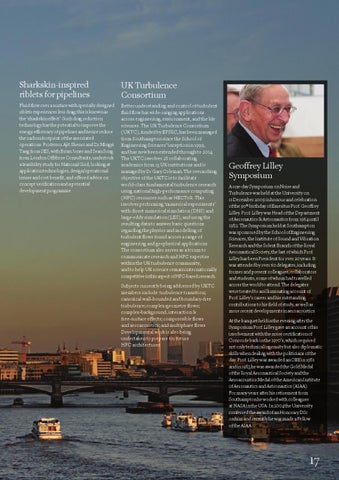Sharkskin-inspired riblets for pipelines
UK Turbulence Consortium
Fluid flow over a surface with specially designed riblets experiences less drag; this is known as the ‘sharkskin effect’. Such drag reduction technology has the potential to improve the energy efficiency of pipelines and hence reduce the carbon footprint of the associated operations. Professor Ajit Shenoi and Dr Mingyi Tang from SES, with Brian Jones and Sean Song from London Offshore Consultants, undertook a feasibility study for National Grid, looking at application technologies, design/operational issues and cost benefit, and offered advice on concept verification and a potential development programme.
Better understanding and control of turbulent fluid flow has wide-ranging applications across engineering, environment, and the life sciences. The UK Turbulence Consortium (UKTC), funded by EPSRC, has been managed from Southampton since the School of Engineering Sciences’ inception in 1999, and has now been extended through to 2014. The UKTC involves 28 collaborating academics from 15 UK institutions and is managed by Dr Gary Coleman. The overarching objective of the UKTC is to facilitate world-class fundamental turbulence research using national high-performance computing (HPC) resources such as HECToR. This involves performing ‘numerical experiments’ with direct numerical simulation (DNS) and large-eddy simulation (LES), and using the resulting data to answer basic questions regarding the physics and modelling of turbulent flows found across a range of engineering and geophysical applications. The consortium also serves as a forum to communicate research and HPC expertise within the UK turbulence community, and to help UK science remain internationally competitive in this aspect of HPC-based research. Subjects currently being addressed by UKTC members include: turbulence transition; canonical wall-bounded and boundary-free turbulence; complex-geometry flows; complex-background, interaction & free-surface effects; compressible flows and aeroacoustics; and multiphase flows. Developmental work is also being undertaken to prepare for future HPC architectures.
Geoffrey Lilley Symposium A one-day Symposium on Noise and Turbulence was held at the University on 11 December 2009 in honour and celebration of the 90th birthday of Emeritus Prof. Geoffrey Lilley. Prof. Lilley was Head of the Department of Aeronautics & Astronautics from 1964 until 1982. The Symposium held at Southampton was sponsored by the School of Engineering Sciences, the Institute of Sound and Vibration Research and the Solent Branch of the Royal Aeronautical Society, the last of which Prof. Lilley has been President for over 20 years. It was attended by over 60 delegates, including former and present colleagues, collaborators and students, some of whom had travelled across the world to attend. The delegates were treated to an illuminating account of Prof. Lilley’s career and his outstanding contributions to his field of study, as well as more recent developments in aeroacoustics. At the banquet held in the evening after the Symposium Prof. Lilley gave an account of his involvement with the noise certification of Concorde back in the 1970’s, which required not only technical ingenuity but also diplomatic skills when dealing with the politicians of the day. Prof. Lilley was awarded an OBE in 1981 and in 1983 he was awarded the Gold Medal of the Royal Aeronautical Society and the Aeroacoustics Medal of the American Institute of Aeronautics and Astronautics (AIAA). For many years after his retirement from Southampton he worked with colleagues at NASA in the USA. In 2004 the University conferred the award of an Honorary DSc on him and recently he was made a Fellow of the AIAA.
17
